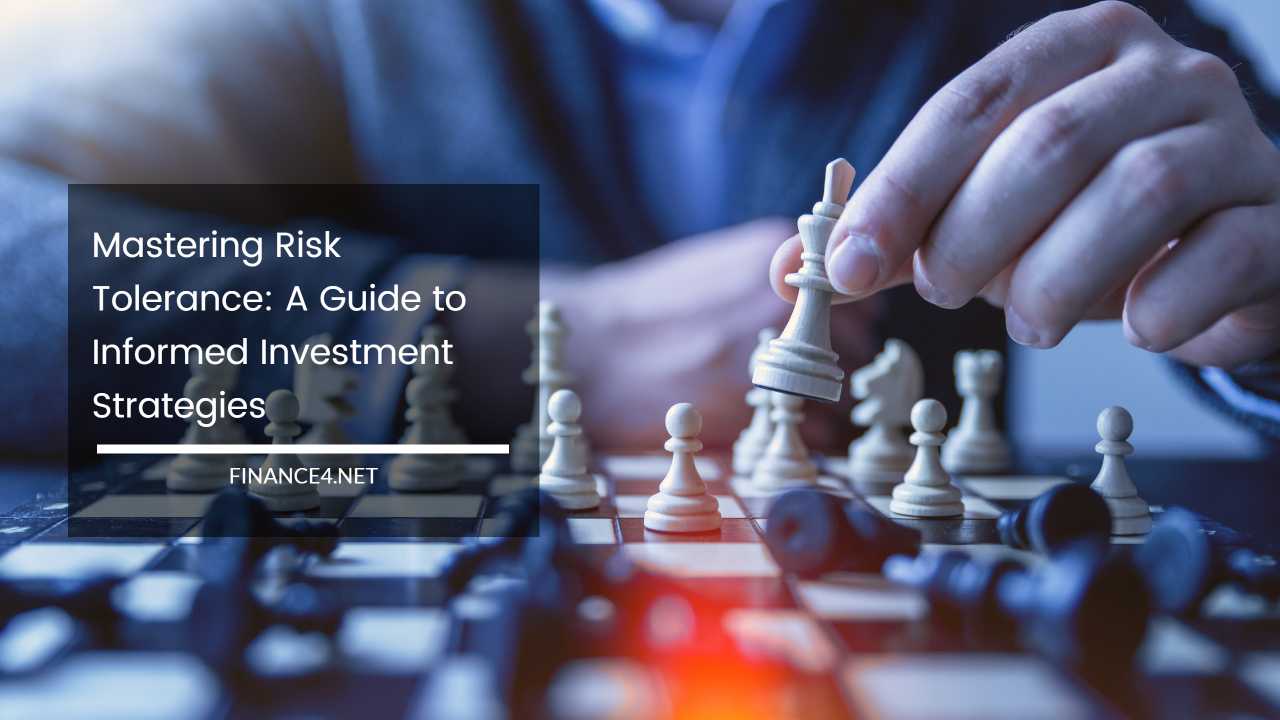Mastering Risk Tolerance: A Guide to Informed Investment Strategies

Risk Tolerance
Determining your risk tolerance is a fundamental step in the world of investing. It serves as a guiding principle for making informed investment decisions, aligning your financial goals with your comfort level regarding risk.
Every individual has a unique risk tolerance, influenced by various factors such as financial objectives, time horizon, and personal emotions towards risk.
In this comprehensive discussion, we will delve deeper into the concept of risk tolerance, exploring its importance, how to assess it, and how it influences investment strategies.
The Significance of Risk Tolerance:
Understanding the significance of risk tolerance is crucial for successful financial planning and investing. Your risk tolerance essentially defines the level of uncertainty you are willing to accept in your investment portfolio.
It serves as a protective mechanism, ensuring that you don’t take on more risk than you can handle. Here are some key aspects of its significance:
- Alignment with Financial Goals: Your risk tolerance is closely linked to your financial objectives. If you have short-term goals like buying a home in the next two years, your risk tolerance would generally be lower as you cannot afford to expose your capital to significant market fluctuations. On the other hand, if you are planning for retirement, which may be decades away, a higher risk tolerance might be suitable as you have more time to ride out market volatility and aim for potentially higher returns.
- Balancing Risk and Reward: Risk and reward are intricately connected in the world of investments. Generally, higher risk investments have the potential for higher returns, but they also come with a higher chance of losing money. Your risk tolerance acts as a balancing mechanism, ensuring that your investment choices align with your willingness to accept potential losses for the prospect of greater gains.
- Emotional Stability: Emotions can cloud judgment when it comes to investment decisions. An understanding of your risk tolerance helps you maintain emotional stability during market fluctuations. If you are risk-averse and your investments experience a downturn, you are less likely to panic and make impulsive decisions that can harm your long-term financial prospects.
Assessing Your Risk Tolerance:
Assessing your risk tolerance involves a systematic evaluation of several factors. It’s not a one-size-fits-all process; rather, it’s a personalized analysis that takes into account your unique financial circumstances and emotional disposition towards risk. Here are the primary components involved in assessing your risk tolerance:
- Financial Goals: Start by clearly defining your financial objectives. Are you saving for retirement, buying a house, funding your child’s education, or simply looking to grow your wealth? Your goals provide the foundation for determining your risk tolerance.
- Investment Horizon: Your time horizon plays a crucial role in assessing risk tolerance. As mentioned earlier, longer investment horizons generally allow for a higher risk tolerance. Calculate the number of years you have until you need to access your invested funds.
- Current Financial Situation: Take an inventory of your current financial situation, including your income, expenses, debts, and existing investments. A comprehensive understanding of your financial health is essential for gauging how much risk you can afford to take.
- Risk Capacity vs. Risk Tolerance: It’s essential to distinguish between your risk capacity and risk tolerance. Risk capacity relates to your financial ability to withstand losses, considering factors like income, savings, and assets. Risk tolerance, on the other hand, is more about your psychological comfort with risk. It’s possible to have a high risk capacity but a low risk tolerance due to emotional factors.
- Psychological Factors: Assess your emotional response to financial risk. How would you feel if your investments declined in value? Are you comfortable with the idea of volatility, or does it cause anxiety? Understanding your emotional reactions can help determine your risk tolerance.
- Risk Assessment Tools: Many financial institutions and online platforms offer risk assessment tools and questionnaires. These tools ask a series of questions to gauge your risk tolerance based on your answers. While they can provide a general idea, it’s essential to complement this with a deeper self-assessment.
Types of Risk Tolerance:
Risk tolerance is not a one-dimensional concept; it exists on a spectrum. Here are three broad categories that investors typically fall into based on their risk tolerance:
- Conservative Investors: Conservative investors have a low risk tolerance. They prioritize capital preservation and are generally averse to significant market fluctuations. They tend to favor low-risk, low-return investments such as bonds, certificates of deposit (CDs), and money market accounts. While these investments offer lower potential returns, they provide a higher level of security.
- Moderate Investors: Moderate investors have a balanced approach to risk. They are willing to accept a moderate level of risk in exchange for the potential for higher returns. This category often includes a mix of stocks, bonds, and other asset classes in their investment portfolios. Their aim is to achieve a reasonable balance between growth and security.
- Aggressive Investors: Aggressive investors have a high risk tolerance. They are comfortable with the idea of market volatility and are willing to take on substantial risk for the potential of significant returns. Their portfolios often consist of a significant allocation to stocks and other high-risk, high-reward investments.
It’s essential to note that your risk tolerance isn’t static; it can evolve over time. Life events, changes in financial circumstances, and shifts in your emotional disposition can all impact your risk tolerance.
Consequently, regular reassessment of your risk tolerance is advisable to ensure that your investment strategy remains aligned with your goals and comfort level.
Factors Influencing Risk Tolerance:
Several factors influence an individual’s risk tolerance, making it a dynamic and personalized concept. Here are some of the key factors that can impact your risk tolerance:
- Age: Age is a significant determinant of risk tolerance. Generally, younger individuals can afford to take on more risk as they have a longer investment horizon to recover from potential losses. Older individuals nearing retirement often have lower risk tolerance as they require more capital preservation to fund their retirement.
- Financial Stability: Your current financial situation plays a vital role in determining risk tolerance. If you have substantial savings and a stable income, you may have a higher risk capacity and, therefore, a higher risk tolerance. Conversely, financial instability can lead to a lower risk tolerance.
- Experience and Knowledge: Experienced investors with a deep understanding of financial markets may have a higher risk tolerance because they are better equipped to assess and manage risk. Novice investors may be more risk-averse due to a lack of experience and knowledge.
- Emotional Resilience: Emotional resilience varies from person to person. Some individuals can remain calm and rational during market downturns, while others may panic and make impulsive decisions. Your emotional resilience significantly affects your risk tolerance.
- Goals and Time Horizon: Your financial goals and time horizon are critical determinants of risk tolerance. Short-term goals may necessitate a lower risk tolerance, while long-term goals can accommodate a higher tolerance for risk.
- Tolerance for Volatility: Some individuals are naturally more comfortable with market volatility and are willing to accept the inherent ups and downs. Others prefer stability and are less tolerant of fluctuations in their investment portfolio.
- Liquidity Needs: If you anticipate needing access to your invested funds in the near future, your risk tolerance may be lower. This is because you cannot afford to expose your capital to significant market fluctuations when you have immediate liquidity needs.
- Investment Knowledge and Education: A solid understanding of investment principles and financial markets can empower you to make informed decisions and potentially increase your risk tolerance.
It’s essential to recognize that these factors interact with each other, creating a nuanced and individualized risk tolerance profile.
For example, a young investor with a high-risk tolerance might become more risk-averse if they experience a significant financial setback.
Psychological Aspects of Risk Tolerance:
Understanding the psychological aspects of risk tolerance is crucial because emotions can often drive investment decisions. Here are some key psychological factors that come into play:
- Loss Aversion: Many investors are more sensitive to losses than gains, a phenomenon known as loss aversion. This psychological bias can lead to risk-averse behavior, where investors are more likely to sell investments at the first sign of a decline to avoid further losses.
- Overconfidence: Overconfidence can lead to an inflated sense of one’s ability to predict market movements. Overconfident investors may take on more risk than they can handle, believing they can beat the market consistently.
- Regret Aversion: Investors often fear the regret of making the wrong decision more than the fear of losing money itself. This can lead to conservative choices and a lower risk tolerance.
- Herding Behavior: Investors sometimes follow the crowd or market trends, even when it goes against their risk tolerance. This herd mentality can lead to impulsive and high-risk decisions.
- Cognitive Biases: Various cognitive biases, such as confirmation bias (seeking information that confirms pre-existing beliefs) and anchoring (relying too heavily on the first piece of information encountered), can distort risk perception and influence risk tolerance.
- Framing: How information is presented can affect risk perception. The same investment can be perceived as either high-risk or low-risk depending on how it is framed.
To mitigate the impact of these psychological factors, it’s essential to maintain a disciplined and rational approach to investing.
This often involves setting clear investment goals, diversifying your portfolio, and adhering to a well-thought-out investment strategy, rather than making impulsive decisions driven by emotion.
The Role of Diversification:
Diversification is a powerful risk management strategy that can help align your investment portfolio with your risk tolerance.
Diversifying means spreading your investments across different asset classes, such as stocks, bonds, real estate, and cash equivalents, as well as across different industries and geographic regions.
Diversification serves several key purposes in managing risk:
- Risk Reduction: By holding a variety of investments, you reduce the impact of a poor-performing asset on your overall portfolio. If one investment experiences a decline, others may perform well, helping to offset potential losses.
- Smoothing Returns: Diversification can lead to more stable and predictable returns over time. While some assets may fluctuate in value, others may remain steady or appreciate, providing a smoother investment experience.
- Enhanced Risk-Return Profile: Diversification allows you to potentially achieve a better risk-return trade-off. By holding a mix of assets with varying risk levels, you can balance potential gains with potential losses.
- Lower Emotional Stress: A diversified portfolio can reduce emotional stress for investors by minimizing the impact of market volatility. Knowing that your investments are spread across different assets can provide peace of mind during turbulent market conditions.
It’s important to note that while diversification can help manage risk, it does not eliminate it entirely. All investments carry some level of risk, and diversification cannot protect against market downturns or economic crises. Therefore, it should be used in conjunction with an appropriate assessment of your risk tolerance and a well-defined investment strategy.
Investment Strategies Based on Risk Tolerance:
Once you have assessed your risk tolerance, you can tailor your investment strategy to align with your comfort level and financial objectives. Here are investment strategies corresponding to different levels of risk tolerance:
- Conservative Investment Strategy: For investors with a low risk tolerance, a conservative strategy focuses on capital preservation and income generation. Key elements of this strategy may include:
- Emphasis on low-risk investments such as bonds, treasury securities, and high-quality dividend-paying stocks.
- A larger allocation to fixed-income securities to provide stability and regular income.
- Limited exposure to volatile assets like equities and alternative investments.
- A focus on preserving wealth rather than pursuing high returns.
- Moderate Investment Strategy: Moderate investors strike a balance between risk and return. Their strategy may include:
- A diversified portfolio that combines a mix of stocks and bonds.
- Allocation to both income-generating assets and growth-oriented assets.
- Periodic rebalancing to maintain the desired asset allocation.
- A long-term perspective with the goal of achieving moderate but sustainable returns.
- Aggressive Investment Strategy: Aggressive investors are willing to take on higher risk for the potential of greater rewards. Their strategy may involve:
- A significant allocation to equities, including individual stocks or equity mutual funds.
- Investment in higher-risk assets such as small-cap stocks, international equities, and alternative investments.
- A long-term horizon to ride out market volatility and capture potential long-term growth.
- A willingness to tolerate larger fluctuations in portfolio value.
- Customized Strategies: Some investors may have unique risk tolerance profiles that require customized strategies. This could involve a combination of different asset classes, investment styles, and risk management techniques. Customized strategies are often designed with the help of financial advisors who take into account the investor’s specific goals and circumstances.
It’s important to note that risk tolerance is not a static characteristic. As your financial situation, goals, and emotional disposition evolve, you may need to adjust your investment strategy accordingly.
Regular portfolio reviews and rebalancing can help ensure that your investments continue to align with your risk tolerance.
Working with Financial Advisors:
Professional financial advisors play a vital role in helping individuals determine their risk tolerance and develop suitable investment strategies.
They have the expertise and experience to guide investors through the complex world of finance and investments. Here’s how financial advisors can assist in this process:
- Risk Assessment: Financial advisors use various tools and questionnaires to assess an individual’s risk tolerance. These assessments take into account financial goals, time horizon, current financial situation, and emotional disposition towards risk.
- Goal Alignment: Advisors work with clients to align their risk tolerance with their financial objectives. They help clients set realistic goals and determine the level of risk necessary to achieve those goals.
- Portfolio Construction: Based on the assessment of risk tolerance and financial goals, advisors design investment portfolios that match the client’s profile. This includes selecting appropriate asset classes, diversification, and asset allocation strategies.
- Regular Monitoring: Advisors provide ongoing monitoring of investment portfolios to ensure they remain in line with the client’s risk tolerance and objectives. They may recommend adjustments as needed due to changing market conditions or personal circumstances.
- Behavioral Coaching: Financial advisors can play a crucial role in helping clients manage their emotions and avoid impulsive investment decisions during periods of market volatility. They provide a rational and disciplined perspective.
- Education: Advisors educate clients about the investment options available, explaining the risks and potential rewards associated with each choice. This empowers clients to make informed decisions.
- Financial Planning: Financial advisors offer comprehensive financial planning services that encompass not only investment management but also retirement planning, estate planning, tax strategies, and more. This holistic approach ensures that all aspects of a client’s financial life are considered.
Choosing a reputable and qualified financial advisor is essential for a successful and productive partnership.
It’s advisable to seek recommendations, check credentials, and interview potential advisors to ensure they are a good fit for your financial needs and goals.
Final Thoughts:
Determining your risk tolerance is a critical step on your financial journey. It’s a deeply personal assessment that considers your financial goals, time horizon, emotional disposition, and various life factors.
Understanding your risk tolerance helps you make investment decisions that align with your objectives and emotional comfort, ultimately increasing the likelihood of achieving financial success.
Remember that risk tolerance is not static; it can change over time. Life events, changes in financial circumstances, and shifts in emotional disposition can all influence your risk tolerance.
Therefore, it’s essential to regularly reassess and adjust your investment strategy as needed to ensure that it remains in sync with your evolving risk profile.
Working with a qualified financial advisor can provide valuable guidance and support throughout this process.
A well-constructed investment strategy, based on a clear understanding of your risk tolerance, can help you navigate the complexities of the financial markets and work toward your long-term financial goals with confidence.



